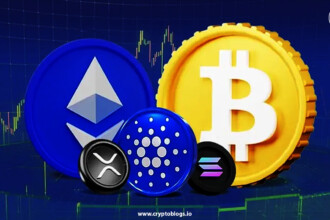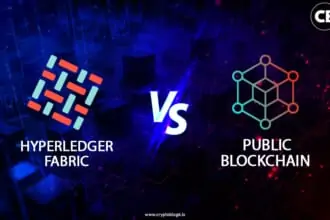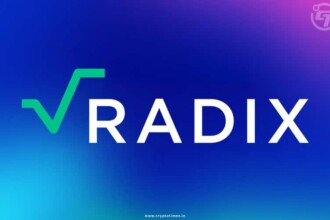The applications of blockchain technology are finding newer corners day after day. Other than its primary use cases in cryptocurrency and decentralized finance, blockchain is making its way towards more industrial and economical use cases. Tokenization is one of these areas where blockchain technology is extending its capabilities.
Industry experts have forecasted that the asset tokenization sector could reach nearly a $5 trillion valuation by the year 2030. The novel characteristics of blockchain, such as immutability, data security, and distributed nature, make it possible to split values into different parts using the method of tokenization.
However, before heading straight into the topic, it is vital to recall the definition of the token.
In the blockchain ecosystem, tokens are digital assets that allow information and value to be stored, transferred, and verified in an efficient and secure manner. Most of these tokens are created on the blockchain using smart contract functionality, and they can be programmed according to their use cases.
Let’s take a deep dive into the fascinating blockchain aspect -Tokenization.
What is Tokenization?
Tokenization is the process of fractionalizing a physical asset or object into tokens and allowing it to distribute its ownership using blockchain. It includes any tangible assets such as real estate, luxury goods, metals, properties, art, etc.
These tokens can come in many forms and can be categorized as security tokens, utility tokens, currencies, etc. All of it has different implications and attributes within the project ecosystem.
The basic idea of tokenization is to transfer ideas, information, and money over the blockchain network without relying on any intermediaries. It essentially enables a decentralized ecosystem where products, goods, and services are available to buy or sell in the form of a token. By breaking an asset into smaller units, tokenization allows the distribution of its ownership rights to a group of people who buy tokens.
In the digital sphere of blockchain, the application of tokenization is one of the most promising and has seen significant traction in recent times. It holds so much potential for the future as any asset from the real world can be tokenized and provided with explicit value in the digital economy.
In addition, tokenization creates opportunities to increase liquidity, improve transaction efficiency, and enhance transparency and provability to asset ownership.
How Tokenization Works
Tokenization makes it easy to buy, sell, and hold the underlying asset as it removes the need for lengthy paperwork or process required to change ownership. The tokens here represent a digital ownership certificate of the underlying asset, which can only be managed and maintained with the owner’s concern.
In the blockchain context, tokenization also enhances security and transparency. Since blockchain is a decentralized and immutable ledger, it ensures that the ownership and transaction records of tokenized assets are secure and cannot be altered retroactively. This feature significantly reduces the risk of fraud and errors.
Additionally, tokenization on blockchain platforms can streamline various processes such as asset transfer, settlement, and compliance, making the overall management of assets more efficient. Tokenization is becoming increasingly popular in various sectors, including finance, art, and real estate, as it opens up new opportunities for investment and asset management in a secure and decentralized manner.
Suppose you have a seaside bungalow which is valued at $1 million. Now, this bungalow can be tokenized on blockchain in 1000 tokens, with each representing $1000 of value. It can have whatever token amount and valuation you want: a hundred tokens, ten thousand tokens, or even a million tokens representing $1 in ownership. If anyone buys these tokens, the amount will be credited to you, and they will hold a certain ownership percentage in your bungalow.
In the process of tokenization, the verification and validation of the asset is done via a smart contract, which serves as the fundamental component. The smart contract decides what values will be assigned to each token and what will be the supply. While creating the contract, the owner also has to go through legal compliance and other matters regarding the object or asset being tokenized.
Tokenization can be performed on both physical and digital assets;
Real World Asset (RWA) Tokenization
The tokenization of real-world assets involves properties, currencies, commodities, art, intellectual properties, etc… As mentioned in the above example, a bungalow can be tokenized in thousands of units, each representing a share of ownership in the form of a token.
Digital Asset Tokenization
Digital assets such as gaming points, images, or audio-video files can also be tokenized on the blockchain. All cryptocurrencies, including Bitcoin, Ethereum, and NFTs, are digital tokenized assets.
Benefits of Tokenization
Besides offering an easy and convenient way of acquiring assets, tokenization offers many more benefits to the digital asset ecosystem. Such benefits are as follows;
1. Transparency
The transparency feature makes asset ownership visible and verified by anyone. It also connects buyers and sellers directly, thus eliminating the need for intermediaries, which comes at an expense. Although the blockchain network is private, tokens can even be tracked and traced with each move.
2. Easy Accessibility
Accessing tokenized assets is easy as the blockchain is open and accessible from everywhere. It can be stored in any blockchain-compatible wallet, which facilitates the sending or receiving of assets. It gives similar access to all the people regardless of any authority.
3. Increased Liquidity
Tokenization helps increase the liquidity of the underlying asset, which may find it complex to trade in the live market. The tokenized assets could be represented in hundreds, thousands, or even millions of tokens, which anyone around the world can own, all thanks to the decentralized nature of blockchain.
4. Streamlined Settlement Processes Using Blockchain
In the traditional method without blockchain, settling an investment involves three steps:
- The trade where buy and sell orders are matched.
- The clearing stage, where clearing members agree to swap cash, creates mutual claims.
- After a standard two-day period for most securities, settlement happens with the transfer of cash for securities via DTC.
Blockchain simplifies this to a two-step process: match and settle, eliminating the clearing phase. Smart contracts enable the direct exchange of cash for securities into each party’s wallet. If this exchange doesn’t happen, the transaction reverses. This quick settlement process allows parties to reallocate their cash and investments more rapidly.
The Future of Tokenization
As mentioned earlier, the tokenization industry is forecasted to reach a $5 trillion market capitalization by the next 5 to 6 years. This metric has already put tokenization as one of the most influential use cases of blockchain that is currently achieving widespread adoption worldwide.
However, the sector is currently under a major development phase, and several applications are being tested as it is quite a new primitive. If the short-term hypothetical scenario of tokenization turns out to be impressive, it could lead the blockchain adoption further than where Bitcoin and other cryptocurrencies have currently led.
Some of the significant traditional companies, including BlackRock and Deloitte, are already conducting and experimenting with tokenization. Several reports have also found that the applications of tokenization have the capacity to disrupt multiple industries, including finance, real estate, entertainment, media, and more. In addition, tech giant Microsoft has also dived deeper into the technology behind tokenization and is reportedly exploring solutions based on it.
Also Read: How Tokenization Changes The Gaming Industry
Conclusion:
Despite being in an early stage of development, tokenization has gained remarkable market adoption in recent times. It has become another major use case of blockchain technology after cryptocurrency and DeFi.
When tokenization reaches its full potential, it is intended to unlock a whole new dimension of asset utilization across different sectors. Furthermore, it will transform the way people interact with real-world assets, making them more transparent and secure than before.
However, It would be too early to say tokenization is all about unicorns and rainbows, as it might face some challenges. However, one cannot deny the fact that tokenization has the potential to take the dream of digitalization to the next level.
FAQs
Q1. What Are the Other Applications of Blockchain Other Than Cryptocurrency?
Ans: Tokenization is another major application of blockchain technology that is slowly expanding across different sectors, such as finance, real estate, and media.
Q2. Are Tokenization and Crypto the Same?
Ans: No, crypto refers to the whole cryptocurrency industry, while tokenization is another sector where blockchain is used.







